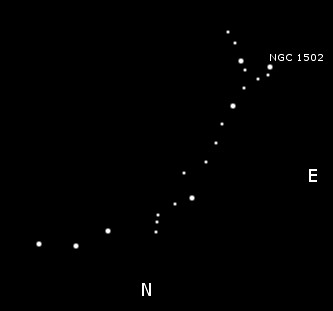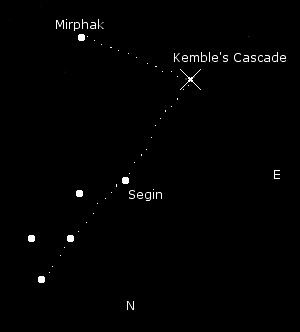This is the second of two groups of stars with interesting patterns I saw around the winter solstice. Had to wear three layers of pants, four layers of tops, a scarf, a cap and ear muffs to fend off the sub-zero temperature.
This group of stars is known as Kemble's Cascade, named after a Canadian friar from Saskatchewan. More information from NASA here. It's really quite pretty through the telescope, looking like stars tumbling down a stream.
A sketch on GIMP 2 (note that the entire chain took up at roughly 3 fields of view through my eyepiece):
Kemble's Cascade includes an open star cluster designated NGC 1502. Although with the limited resolving power of my telescope I could only make it out as a rather bright star (top right of the sketch).
A star cluster is a group of stars that are bound together by gravity. You might say that the attraction is mutual.
On the other hand, the entire chain of stars along the cascade is not gravitationally-bound. They look like they form a chain but in actual fact are probably millions of light years away from one another. Such fortuitous associations are known as asterisms.
To put it another way, you stand in front of a tree and see the moon above your neighbour's satellite dish across the street. The moon may look like it's hovering 2 feet above the dish but you know they're a few million miles apart.
It's all about perspective.
To locate Kemble's Cascade, see the sketch below:
First find Mirphak, our star in Perseus featured in my previous post. Then look for the M-shaped constellation Cassiopeia. Kemble's Cascade roughly forms a right angle triangle with Mirphak and Segin, the star making the right foot of the M.


No comments:
Post a Comment